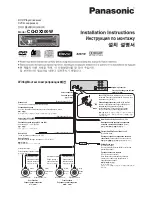
Installation and Setup
40
Instruction Manual – DXLink™ Twisted Pair Transmitters/Receiver
Functions of DXLink Transmitters and Receivers
The diagram in FIG. 14 shows the functions of DXLink Transmitters and Receivers. The example descriptions contain
the device HDCP key count when used in conjunction with DXLink Boards in an Enova DGX Digital Media Switcher
and when using a Transmitter and Receiver as a standalone pair.
Endpoint Mode (Standalone): Example of Typical System Setup
A standalone DXLink TX/RX pair are connected directly to each other but, in addition, either the TX or RX is connected
to a NetLinx Central Controller via a LAN or directly to the Controller.
FIG. 14
Repeater and source functions of TX/RX Modules (A, B, D also apply to Wallplate TX and Decor Wallplate TX)
FIG. 15
Endpoint Mode (Standalone) with NetLinx Central Controller
Twisted pair cable
Twisted pair cable
Twisted pair cable
Twisted pair cable
Source
Destination
Destination
Destination
Destination
Source
Source
Source
HDMI
cable
HDMI
cable
HDMI cable
HDMI
cable
HDMI cable
HDMI
cable
HDMI
cable
HDMI
cable
Twisted pair cable
Switcher
Switcher
Switcher
TX acts like a repeater
TX acts like a sink
TX acts like a sink
Example A:
When a Receiver acts like a source, its key does not count. Source device sees 1 key (Transmitter).
Example B:
When a Transmitter acts like a sink, the source device sees 1 key (Transmitter).
Example C:
When a source device is connected directly to a switcher, the source sees 1 key (switcher input).
Example D:
When a Transmitter is part of a standalone pair, its key does not count. Source device sees 2 keys.
RX acts like a repeater
RX acts like a source
RX acts like a source
HDMI Out
DXLink Out
DXLink Out
HDMI In
DXLink In
DXLink In
Example B
Example C
Example D
Example A
Acts like
a sink
Twisted pair cable
NetLinx Central Controller
Destination device
DXLink
Transmitter
DXLink Receiver
Source device
















































